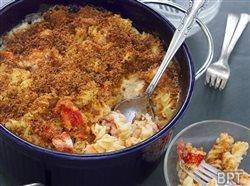Hook holiday guests with these secrets of serving seafood
(BPT) - When you’re brain-storming holiday menus, do lovingly roasted turkeys with all the trimmings and decadent cookies dance alongside the peppermint and sugarplums in your visions? Certain flavors and foods are strongly associated with the holiday season – seafood, however, isn’t always among those favored dishes. But it could be! The right seasonings and a dash of creativity – along with historically low prices on well-loved options like lobster – could make seafood a centerpiece of your holiday menus.
Serving seafood can allow you to combine both the “wow factor” your family and guests crave in a holiday meal with the nutritional benefits they deserve. Nutrient-rich seafood is a good source of protein, vitamins and minerals, as well as omega-3 fatty acids DHA and EPA. Plus, with a wide variety of textures and flavors to choose from, you’re sure to find a type of seafood that appeals to every person at your table.
Here are three secrets to incorporating seafood into your holiday entertaining:
1. Buy as close to fresh as possible.
Unless you live in a fishing village, it’s almost impossible to get truly fresh fish. Most seafood will have been refrigerated and/or frozen at some point in its journey from the water to your grocery store – and that’s perfectly fine. In fact, if the seafood were left unfrozen, it could easily spoil by the time it reached the market, so don’t discount a selection because you suspect, or are sure, it’s been frozen. Instead, consider how the fish or shellfish looks and smells – and in the case of live shellfish, how it acts.
The U.S. Food and Drug Administration says fish should smell fresh, not “fishy.” The flesh should be shiny, firm and free of slime for both whole fish and fillets. Uncooked shrimp should be translucent and shiny, with no strong odor. If you’re buying live lobster or crab, avoid ones that appear lethargic, and instead look for ones that show leg movement. For live shellfish, tap the shell before buying. If the animal inside is alive and healthy, the shell should snap shut.
2. Variety is the spice of life.
Let’s be honest – even people who eat a lot of seafood often reach for the same old seasoning week after week, regardless of the time of year. Traditional seafood seasoning is flavorful, appealing and versatile – hence its popularity. But if you would like that flavor in organic versions with a more robust taste, maybe a Cajun twist, or even a version with less salt, try something new.
Frontier Natural Products offers three organic seafood seasonings – Original, Reduced Sodium and Blackened – that enhance a variety of seafood dishes. Made with certified organic, premium spices, all three flavors use real sea salt rather than evaporated table salt. Kosher-certified by KSA, the seasonings also help restore America’s wetlands – 1 percent of sales of the spices goes toward wetland preservation and restoration.
Mix up your approach with these seasonings. Sure, they’re great sprinkled atop a grilled or baked fillet, but how about as an ingredient in lobster macaroni and cheese? Or as the flavor that gives an extra zing to a crab dip?
3. Par for every course – and time of day.
Some people only feel confident serving fillets as an entree. Others can manage a crab dip appetizer but can’t envision basing an entire meal on seafood. Still others would never dream that seafood could work well on their breakfast table. Because of its variety and versatility, seafood can be great for any – or every – course and served at any time of day, from breakfast to a late-night snack.
Can’t imagine how seafood fits into a breakfast? Try incorporating leftover lobster in your scrambled eggs, a la Seinfeld’s George Costanza. Or, substitute a crab cake for the English muffin and give traditional Eggs Benedict a whole new appeal. An updated tuna salad or well-seasoned chowder is always great for lunch. And dinner can be a seafood extravaganza with appetizer and entree both going swimmingly with the holiday season.
You’ll find plenty of seafood recipes at Frontiercoop.com. Here’s one that echoes the holiday season’s blend of comfort and excitement by using lobster to give classic macaroni and cheese a sophisticated, celebratory flair:
Smoked Gouda Lobster Macaroni and Cheese
Prep time: 20 minutes
Cook time: 35 to 40 minutes
Serves five.
Ingredients:
5 tablespoons unsalted butter, divided
3 teaspoons Frontier Original Organic Seafood Seasoning, divided
1/3 cup whole wheat bread crumbs
8 ounces uncooked rotini (or other pasta)
2 tablespoons all-purpose flour
1 1/4 cups 1 percent milk
1/4 cup heavy whipping cream
2 tablespoons lemon juice
1/4 cup sour cream
4 ounces smoked Gouda cheese, grated
6 ounces sharp cheddar cheese, grated
6 ounces raw lobster tail meat, cut into pieces (thaw if frozen)
1 1/2 teaspoons medium grind black pepper
Directions:
Preheat oven to 400 degrees. Fill a large pot with water and bring to a boil. Meanwhile, melt one tablespoon butter. In a small bowl, combine melted butter, 1 teaspoon Seafood Seasoning and bread crumbs. Set aside.
Add rotini to the boiling water and cook until al dente, according to package directions. Drain pasta and reserve.
In a large saucepan, melt four tablespoons butter and add flour. Cook over medium heat, whisking, three to four minutes, until golden. Gradually add milk to flour mixture, whisking. Bring to a boil, whisking constantly, then reduce heat to low.
Add the heavy cream, lemon juice, sour cream, Gouda cheese, cheddar cheese and two teaspoons Seafood Seasoning, stirring until cheeses are melted and sauce is smooth.
Spray a 9-by-9-inch pan with nonstick cooking spray and place cooked pasta and lobster in pan. Pour cheese sauce into pan and mix everything together.
Sprinkle breadcrumb mixture on top of macaroni and cheese, and then bake for 15 to 20 minutes, until the cheese is bubbly and the breadcrumbs are browned. Sprinkle final dish with black pepper.























